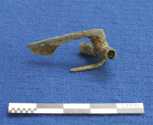
Copper-alloy brooch SF3758
(Note: The images linked to the small finds records were often taken before conservation.)
No full-scale analysis of the 'House 1' small finds has yet been undertaken, but it is apparent that the close dating evidence of the sequence rests largely with the brooches. There are, nevertheless, a number of other items of considerable intrinsic interest that date either to the transitional Late Iron Age/Early Roman period or the Early Roman period. Three groups of objects are therefore briefly described and discussed: the brooches, the toilet instruments and a small group of miscellaneous items.
Seven Objects produced brooches or fragments of brooches: 50010, 50017 and 50034 from Period 2 (ERTB2 and 3); 50018, 50019 and 50037 from Period 3 (ERTB4 and ERMB1 and ERMB2), and the Period 4 Object 50046 (MRMB3). Some of the pieces are small fragments of the spring or pin that cannot be closely dated, others are complete or more or less complete brooches datable to within 20-40 years or so. The latter only are summarised below.

Copper-alloy brooch SF3758
(Note: The images linked to the small finds records were often taken before conservation.)
Several of the brooches are Iron Age types: a British-made Colchester brooch (SF02786) and a range of spring-cover brooches imported from Gaul, i.e. two Langton Downs (SF04045, SF01255), one Rosette (SF03084), and an unusual small plain brooch that is probably a miniature votive (SF03758). All these belong to the first half of the 1st century AD, with their manufacture/import ceasing at the conquest and all likely to have been in the ground by AD 50.
The miniature spring-cover brooch and one of the Langton Down brooches (SF04045) came from contexts associated with the construction of the Period 2 circular structure (Building 3), Object 50010. The miniature was in gravel make-up and was almost certainly deposited as part of a formal rite associated with the building's construction, and the Langton Down, which is complete, came from the floor and may have been similarly deposited when the floor was laid, or buried later in a scrape as a votive.
The Rosette brooch (SF3084) came from the clay foundation associated with Room 6 of the Period 2 Timber Building (Object 50034), a context that also indicates that it was a votive deposit. Like both the miniature spring-cover and Langton Down brooches in Object 50010, it is only slightly damaged, and may have been complete and in good condition when buried.
A Hod Hill brooch (c. 43-60/5; SF02269) and several copper-alloy Nauheim derivatives (43-c. 80/5; SF04089, SF03679, SF03913, SF03133, SF02639, SF01232 and SF01286) represent the conquest period, with both arriving in Britain in considerable numbers with, or on the heels of, the Roman army.
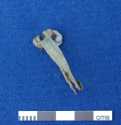
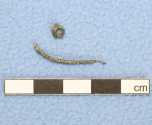
Left: SF3913 Nauheim Derivative Brooch
Right: SF2639 - Copper-alloy brooch fragments
(The term Nauheim derivative is unfortunate, as there is a hiatus between the date-ranges of the Nauheim
proper and of these small one-piece brooches. In Fulford and Timby 2000, Corney (2000) grouped many of the Late Iron
Age and early Roman one-piece brooches together under the heading of 'Nauheim derivatives', but here the term
is confined to the post-conquest continental imports sometimes referred to as 'Soldatenfibeln'.)
Nauheim derivatives are particular well represented, occurring in all Periods 2-4, and they are common on the site in general. Contemporary British-made forms found in 'House 1' are a Rearhook brooch (dated c. 40-60/5; SF04044), a Colchester B derivative (c. 50-70; SF03933), a BB derivative (c. 65-80; SF01077), and a Polden Hill brooch (c. 40-80; SF02486/SF02501). Several of these brooches were residual in Periods 3 and 4 levelling or make-up deposits, although SF4089 came from the Period 2 Timber Building 2 (Object 50017). SF03679 was from a clay deposit within the hearth in the Period 2 circular structure (Building 3) (Object 50010), and SF03913 and SF03933 (the latter a little out of its usual date range) were from a Period 3 accumulation layer in Masonry Building 1, Object 50018.
Three Flavian-Hadrianic or Antonine brooches occur in Period 3 in Timber Building 4: a Fowler Type D5 penannular (SF02877) and two western T-shaped brooches (SF02985, SF03256). Unlike many of the brooches above, which were residual in make-up or levelling deposits, these three are contemporary with their site phase.
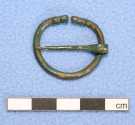
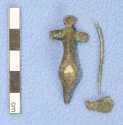
Left: SF2877 - Copper-alloy penannular brooch
Right: SF2985 - Copper-alloy brooch
The residual nature of many of the brooches is particularly evident for those from the Period 4 Masonry Building (Object 50046), which contained the Colchester BB derivative SF01077, the Rearhook SF04044 and two Nauheim derivatives, SF01232 and SF01286. The only brooch fragment from this Object that may possibly be contemporary with it is a tool from a 2nd-century chatelaine brooch (SF02589), although even this, judging by its recovery in clay deposited in the north aisle, is more likely to be residual.
In terms of source, it is worth noting that, despite the small number of brooches present and the large element of residuality, the brooch assemblage from 'House 1' represents a condensed version of the brooch supply to Silchester from the Late Iron Age into the 2nd century, and also reflects the general decline in brooch use evident in southern Britain from c. 80/5 onwards. In the first half of the 1st century AD Gaulish Langton Downs and Rosettes predominated, succeeded after the conquest by the imported Nauheim derivatives and a comparatively small number of British-made brooches, generally of eastern manufacture (Rearhook, Colchester B and BB derivatives). As these fell into disuse no further imports or eastern British brooches replaced them and, although a few western British T-shaped types and penannulars reached the site, which in the case of the T-shapes lay on or close to the eastern limit of their distribution, the number of brooches entering the archaeological record fell away. In the case of female costume this reflects a shift away from the La Tène and early Romano-British tube-dress, fastened by a brooch on each shoulder, towards the Roman gap-sleeved tunic that was fastened at intervals down the upper arm (Croom 2002, 79-80).
The brooch assemblage from the 'House 1' sequence therefore not only encapsulates the transition from the Late Iron Age into the Roman period at Silchester, but also demonstrates a shift in brooch supply from east to west and records the increasing influence of Roman tastes and fashions among the population, to such an extent that after the mid-2nd century no brooches appear in primary contexts associated with the occupation of the building.
SF04089: the top of a Nauheim derivative brooch with plain narrow bow. Date range c. AD 43-c. 80/5.
SF03084: Rosette brooch with circular disc bearing toothed rosette, complete apart from tip of pin, date range c. AD 10-50.
SF04045: complete Langton Down brooch with rounded head and reeded bow, date range c. AD 10-50.
SF03758: complete small spring-cover brooch with plain narrow bow turning sharply at a right angle from the head, probably a model votive, date range c. AD 10-50.
SF03679: the pin, spring and chord from a Nauheim derivative brooch, date range c. AD 43-c. 80/5.
SF01255: the foot of a Langton Down brooch, date range c. AD 10-50.
SF02486, SF02501: a light Polden Hill brooch, complete although bow and spring were found separately in the same context, date range c. AD 40-80.
SF03933: a complete Colchester B derivative brooch, with a fine incised zigzag on the bow, date range c. AD 50-70.
SF03913: a complete Nauheim derivative brooch, with knurled margins and knife-edge foot, date range c. AD 43-c. 80/5.
SF02786: a complete Colchester brooch with plain rounded bow, date range late 1st century BC to c. AD 50.
SF03133: fragment of a Nauheim derivative brooch with wire bow, date range c. AD 43-c. 80/5.
SF02269: a Hod Hill brooch with lugs at the top of the bow, the pin is missing, date range c. AD 43-60/5.
SF02639: fragment of a Nauheim derivative brooch with plain flat bow, date range c. A D43-c. 80/5.
SF02877: a Fowler Type C penannular brooch with clinched zoomorphic terminals, angled nicks along the top of the bow, and a cross on the pin loop; date range 1st-2nd century, or later.
SF02985: a T-shaped brooch with enamelled lozenge on the bow. Date range late 1st to early 2nd century.
SF03256: T-shaped brooch with Polden Hill spring mechanism and enamelled upper bow, date range c. AD 65-125.
SF01077: Colchester BB derivative brooch, missing its pin, date range c. AD 65-80.
SF01232: Nauheim derivative brooch, complete, ?plain bow (corroded), date range c. AD 43-c. 80/5.
SF01286: Nauheim derivative brooch fragment, wire bow, date range c. AD 43-c. 80/5.
SF02589: tool from chatelaine brooch, functional tip missing, probably a single pick or a nail cleaner; date range 2nd century.
SF04044: Rearhook brooch fragment. Date range c. AD 40-60/5.
The toilet instruments recovered from the site consist chiefly of bifid (double-pointed) nail-cleaners, tweezers and sets composed of nail-cleaners, tweezers and ear-scoops. In addition, there is one long-handled toilet spoon and a fragment of a stirring rod. A tool from a chatelaine brooch, discussed above under 'The brooches', is also pertinent to this assemblage.
Bifid nail-cleaners are an artefact type that flourished in Britain in the Roman period despite being an insular survival from an earlier La Tène tradition. On the Continent they were driven out of use by the cultural shift to a Roman life-style and practices, but in Britain the conquest gave a dramatically sharp boost to their manufacture and they continued to be used, although in declining numbers, into the late 4th/early 5th centuries (Crummy and Eckardt 2004). Their presence in the early Roman period is therefore a strong indication of a British population and in London their zonal distribution defines clear areas of British settlement in the eastern suburbs and in Southwark on the south bank (Crummy forthcoming).
The only toilet instrument recovered from a Period 1 context is an iron bifid nail-cleaner (SF03953) found in Object 50033. Few small iron toilet instruments are known from Britain, partly because of their size and poor chance of survival, and partly because corroded incomplete examples might not have been recognised in the past without benefit of X-radiography. Examples come from pre- and post-conquest graves at King Harry Lane, Verulamium, and from post-conquest Londinium (Stead and Rigby 1989, Graves 122 and 242; Crummy forthcoming, fig. 1, 3). The recovery of this example from such an early context suggests that, like many of the brooches from Periods 1 and 2, it is of pre-conquest origin.
In Period 3, Object 50019 (Masonry Building 2) is remarkable for having produced two complete sets of toilet instruments (SF02942, SF02961), with the bellied blade of the nail-cleaner in SF02942 perhaps pointing to manufacture in the Wiltshire/Dorset area of southern Britain. Complete sets are rare as site finds, generally only being recovered from funerary or votive contexts, and the recovery of both these sets from levelling deposits laid down during the construction of Object 50019 is in tune with a votive interpretation. In contrast, a blade from broken tweezers from the fill of a possible post-hole associated with Object 50019 is more likely to be general rubbish (SF03098).

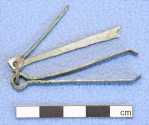
Left: SF2942 - Copper-alloy toilet set
Right: SF2961 - Copper-alloy toilet set
Object 50037 in Period 3 (Timber Building 4) also produced a complete toilet set, as well as a nail-cleaner, two tweezers and a long-handled toilet spoon. The set came from a clay layer associated with the construction of Town House 1, and can again be interpreted as a votive deposit (SF02079). One of the tweezers came from a clay floor associated with a large hearth and may also be a deliberate deposit (SF03484). It is also of intrinsic interest because, with its wide jaws, and twist of wire below the spring, it may have served a medical rather than cosmetic purpose. The other tweezers, the long-handled toilet spoon, and the nail-cleaner – the latter quite damaged – appear to have no special character within their contexts (SF02422, SF02576, SF02793), although it is worth noting that the spoon represents an introduced artefact type and may have been used either for cosmetics or for medical ointments.
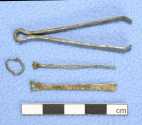

Left: SF2079 - Copper-alloy toilet set
Right: SF2576 - Copper-alloy toilet spoon
The toilet instruments from the Period 4 Object 50046 consist only of a fragment of a glass stirring-rod (another introduced artefact type (SF00830)), a nail-cleaner (SF01711) and a tool from a chatelaine brooch (discussed above in the section on brooches). All came from general rubbish deposits.
In terms of production and supply, the absence from the site of the nail-cleaner types that predominated in eastern and western Britain (Crummy and Eckardt 2004) is a strong indication that the examples found at Silchester were manufactured either locally or within the surrounding region, with the bellied blade of the cleaner (SF2942) hinting at a Durotrigian origin for that set. The general pattern of distribution of toilet instruments within the 'House 1' sequence points to a ritual use of small toilet sets (incorporating nail-cleaners) during the construction of some elements of the buildings in Period 3. This in turn clearly demonstrates that the builders, and presumably therefore also the inhabitants, of Masonry Buildings 1 and 2 were of British origin, rather than incomers drawn to the town in the wake of the conquest. Introduced toilet instrument types do not appear until the end of the 1st century or the beginning of the 2nd, and then only in low numbers and with no special character attached to their deposition.
SF03953: iron nail-cleaner with narrow leaf-shaped blade and suspension loop in the same plane as the blade.
SF02942: copper-alloy toilet set of tweezers, nail-cleaner and ear-scoop; nail-cleaner has bellied blade and long points, a form characteristically found in the territory of the Durotriges.
SF02961: copper-alloy toilet set of tweezers, nail-cleaner and ear-scoop; the nail-cleaner has a simple flared blade with decorative notching at the top of the edges of one face; the tweezers have notching at the top of both blades.
SF03098: one blade, with marginal grooves, from copper-alloy tweezers.
SF02079: copper-alloy toilet set of tweezers, nail-cleaner and ear-scoop; nail-cleaner has plain flared blade.
SF02422: copper-alloy tweezers with plain flared blades.
SF02576: copper-alloy long-handled toilet spoon with spiral decoration above round dished scoop.
SF02793: copper-alloy nail-cleaner with plain flared blade.
SF03484: copper-alloy tweezers with plain flared blades and wide jaws; there is a twist of wire below the spring.
SF00830: blue/green glass stirring rod fragment.
SF01711: copper-alloy nail-cleaner with straight-sided blade.
(SF02589, toilet instrument from chatelaine brooch - see 'The brooches' above.)
This section includes the beads, a foot and a strainer-plate that probably come from the same metal vessel, and a part of a medical scalpel/blunt dissector.
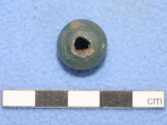
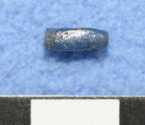
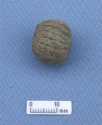
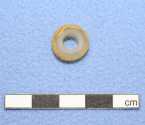
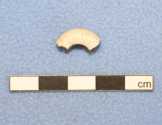
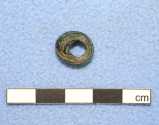
Glass beads: SF807, SF2136, SF3908, SF3964 (with wavy decoration), SF4027, SF4062
The beads are few in number, but together with the assemblage from the Forum-Basilica site they provide an insight into the types popular in Silchester in the Late Iron Age/early Roman period. There are no large annular beads so characteristic of the Late Iron Age elsewhere but rather three small annular beads ( SF03964, SF04027, SF04062) (Allen and Boon 2000, 321, nos 5, 7). Only analysis of the glass can determine if these are locally made or imported items, but they certainly point to a preferred style in mid-1st century AD Silchester.
Three more melon beads were found in Period 3 contexts, one only a fragment (SF02635, SF02796, SF03493), but there were no other beads from this phase. There are too few to be certain that the type completely supplanted the demand for annular beads, but the recovery of another six from the Forum-Basilica site points to their general popularity at Silchester in the later 1st century AD.
By Period 4 a mix of beads is present (SF00807, SF02136, SF03018), but again the numbers are too few for meaningful conclusions to be drawn, and at least one, a melon bead fragment (SF3018), is likely to be residual.
Object 50010 in Period 2 (Timber Building 3) also produced a turquoise frit melon bead (SF03908), a type introduced at the conquest and indicative of a Gallo-Roman element to the population. There has so far been no research to determine how quickly these beads passed into use by the indigenous population, if at all, but they point to the introduction of a new form of personal ornament.
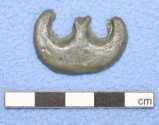
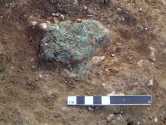

Left: SF2013 - Copper-alloy fitting
Middle: Copper-alloy strainer in situ (SF02958)
Right: Copper-alloy strainer (SF02958)
Two particularly intriguing items are a copper-alloy vessel foot and a decoratively pierced copper-alloy strainer plate (SF02013, SF02958). The evidence for proposing that these pieces both come from a single metal vessel rests not on the fact that both derive from the Period 4 Masonry Building 3 (Object 50046), but on their both being components of a particular type of vessel, a carinated spouted strainer bowl, which had feet, spout and strainer-plate all made separately and then soldered onto the body. The strainer-plate had been folded before deposition and was in an extremely poor condition in situ, but it was carefully lifted in a soil block and excavated in Colchester Museum's Conservation laboratory. Nearly all the metal had perished to dust, and very little now survives (see above), but it was clearly part of a plate similar to those found on strainer bowls such as that from the richly furnished Welwyn Garden City grave dated to c. 10 BC (Stead 1967), and, more particularly, the British-made carinated bowls from Crownthorpe, Norfolk (Norwich Castle Museum), the healer's grave at Stanway, Essex (Crummy et al. forthcoming), CF47.22), the legionary fortress at Alchester, Oxfordshire (E. Sauer, pers. comm.) and from Blain, Loire-Atlantique (S. Corson, pers. comm.). These carinated spouted strainer bowls were also fitted with peltate feet considerably larger than those generally found on continental-made metal vessels, and the Silchester foot is of this large type. The recovery of both the strainer-plate and the foot in close proximity in Object 50046 is unlikely to be simply a coincidence. Both can be presumed with a reasonable degree of confidence to have come from the same vessel, although in this Object the fragments are almost certainly beyond their horizon of use.
The British-made strainer bowls were not used to heat wine. Their capacity is much greater than that of the continental-made metal saucepans and wine strainer sets, and Sealey has argued that, as an indigenous vessel type, they were used for an indigenous drink, such as beer flavoured with herbs or other additives (1999, 123-4). Herbal teas may be another possibility, as the Stanway bowl retained a plug of artemisia in the spout and its final use appears to have been to brew a tea flavoured with this herb and honey (Crummy et al. forthcoming).
Strainer bowls also occur in pottery, the rounded form CAM 322 and the carinated form CAM 323, most examples of which come from Hertfordshire and Essex, the territory of the Catuvellauni and Trinovantes. They are concentrated in and around Camulodunum and are generally from early post-conquest contexts (Hawkes and Hull 1947, fig. 50, 8; Niblett 1985, fig. 33, 2; Sealey 1999, 119-24). The metal vessels, too, although comparatively rare, are largely concentrated in eastern Britain, but the recovery of the Alchester example extended the range to the periphery of Catuvellaunian influence. The Silchester fragments extend it again into the heartland of the Atrebates, while two from a hoard of metal vessels recently found at Kingston Deverill, Wiltshire, push it still further west (Worrell 2006, 458-62). The bowl from France can be seen as the property of a migrant (eastern) Briton, as Blain lies near the mouth of the Loire, and the vessel was found in a well that had been backfilled in the mid-1st century AD. It is in excellent condition and is more likely to have been a votive offering, like the Crownthorpe bowl, than discarded household rubbish. The Silchester fragments, on the other hand, can be presumed to have come from a bowl that saw considerable use. The foot could have become detached and the plate may have become worn and replaced, which would account for its folded and crumpled state, and this possibility is strengthened by the fact that the Stanway strainer-plate had become loose at one point on the edge and then soldered back into position.
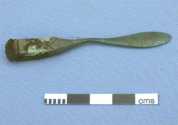
SF3880 - Copper-alloy surgical instrument
Also from Period 4 Masonry Building 3, Object 50046, is a ceramic animal figurine represented by four fragments found in beam slot 3348/3987 for the verandah. The pieces consist of the upper part of a leg, another leg fragment, a body fragment, and a piece with random incised angled grooves that probably represents a loosely flowing mane rather than a crest. Although the identification is necessarily tentative, given the lack of positive features, all these pieces could be accommodated as part of a horse (see, for example, Rouvier-Jeanlin 1972, cat. nos 972-1020). That four non-fitting fragments are present may imply deliberate breaking and selection for votive purposes, and the context matches the foundation deposits seen elsewhere in this group of material.
The final object included here is part of a surgical instrument, found in gravel post-dating the Period 2 circular structure (Object 50010) but pre-dating the Period 3 Masonry Building 2 that replaced it (Object 50019), and therefore belonging to the early 2nd century. The date suggested by the context matches the general 1st to early 2nd-century date of the object type (Jackson 1986, 120). The instrument (SF03880) is a scalpel/blunt dissector, of which only traces of the blade now remain. The copper-alloy handle/dissector has a very low median ridge on each face. The central grip is plain and rectangular, with rolled-back terminals and a 'key-hole' socket that retains a circular pin for fixing the blade in place. The object would originally have been part of a set, a surgeon's instrumentarium, and would not have been discarded lightly. Its presence on the site probably therefore represents genuine accidental loss.
SF04027: annular bead of opaque white glass.
SF03964: small annular bead of translucent colourless glass with yellow zigzag spiral trail.
SF04062: small annular bead of translucent green glass.
SF03908: turquoise frit melon bead.
SF03880: iron/copper-alloy scalpel/blunt dissector.
SF02635: fragment of a turquoise frit melon bead.
SF02796: turquoise frit melon bead.
SF03493: turquoise frit melon bead.
SF807: globular bead of green glass.
SF02136: small cylinder bead of opaque blue glass.
SF03018: turquoise frit melon bead fragment.
SF02013: peltate vessel foot.
SF02958: vessel strainer-plate.
Context 3674 (fill of 3987=3348): four fragments of a ceramic animal figurine.
© Internet Archaeology
URL: http://intarch.ac.uk/journal/issue21/4/finds_sf.htm
Last updated: Wed Sept 12 2007